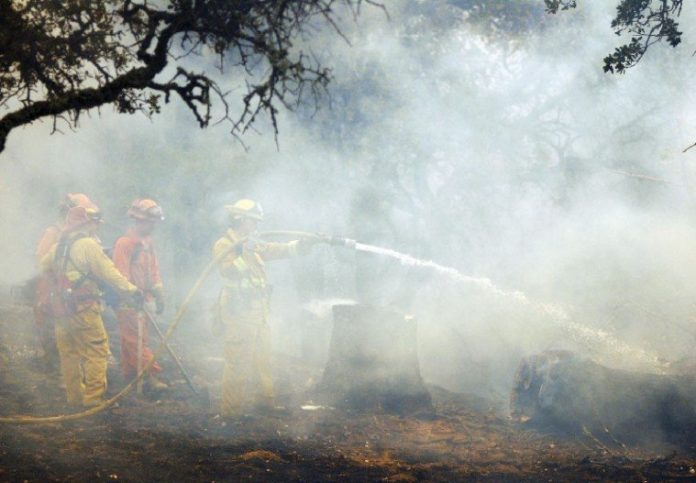Helicopters, tankers and ground crews are gradually conquering
the 27,640-acre Lick Fire scorching Henry Coe Park, in a
multi-pronged attack.
Gilroy – Helicopters, tankers and ground crews are gradually conquering the 27,640-acre Lick Fire scorching Henry Coe Park, in a multi-pronged attack. But about 16 miles bordering the fire remained unprotected Thursday morning – 65 percent of its total perimeter, said CalFire spokesman Fred Orsborn – and the blaze could take weeks to extinguish entirely.
More than 1,825 people are fighting the flames, behind the wheels of 200 engines, 29 dozers, 18 water tenders, eight helicopters and nearly a dozen air tankers.
“It takes large-scale coordination to do this,” said Pat Antrim, a battalion chief from Orange County Fire Authority, as he watched crews charring vegetation in the park’s southeast, starving the oncoming fire of fuel.
After fording through rush-hour traffic in Los Angeles, his crew arrived in Gilroy at 2am Wednesday, slept a few hours, and began work Thursday. They aimed to halt the fire’s advance in the southeast section of the park by burning wide swaths of land. “It’s very similar to a battlefield.”
Thursday afternoon, CalFire spokesman Jim Dethlefson said the east and west edges of the fire were stable behind “contingency lines” burned by crews. Coral-pink retardant, poured onto the lines, douses wayward flames. To quench the dense vegetation, crews are using four to six gallons of retardant per 100 square feet, said CalFire airtanker pilot Russ Looney.
But the lines aren’t invincible: Wednesday night, flames leapt over County Line Road toward Stanislaus County, breaching a contingency line. The fire was moving southeast by midday, far from homes and cities. Western winds were pushing the blaze east, and slowly cooling the flames. But low humidity worried CalFire staff such as Dethlefson, who said Thursday’s 17 to 21 percent humidity might help spark “spot fires” at a distance from the central blaze.
The Lick Fire has caused four minor firefighter injuries, such as heat stroke and bee stings, and destroyed one outbuilding. No one was injured Wednesday or Thursday.
Thursday morning, 25 park buildings, including cabins and outbuildings, were threatened. The wildfire was burning south of Red Creek, east of Colt Road, and west of Orestimba Creek – a trouble spot, Orsborn said.
Crews were still working Thursday to cut contingency lines to the north and south of the fire. Inmate crews in orange jumpsuits hacked at manzanita bushes with chainsaws and hoes. From the skies, helicopters circled, scouting out the fire’s spread. Alongside them, a new tool is at work in the skies: The DC-10 tanker from Victorville in San Bernardino County, which can dump 12,000 gallons of retardant at a time. But the bulkier plane has its disadvantages, too, said Calfire Captain Steve Norris, a pilot, including less maneuverability between the steep ridges where the blaze is burning.
Tankers such as the DC-10 were scarce: Soupy smoke grounded tankers Thursday morning. Looney estimated visibility at five to seven miles, “standard for Southern California,” he joked.
“We have to get up 8,000 feet to see through the smoke,” explained Norris, who was one of the first pilots to attack the Lick Fire from the skies. “We can use GPS to pinpoint a location, but to fly strictly by GPS? No, we can’t do that … And that’s making the ground crews’ job harder.”
Despite the smoke, eight helicopters still alighted from a field near Casa de Fruta to lob water on the fire.
The Lick Fire has been traced to an illegal burn barrel, lit on private lands in the park’s northwest. Thus far, CalFire officials have not identified the person responsible, or the owner of the property where the barrel was lit. No arrests or citations had been made by press time Thursday. The person responsible could be held liable for the fire’s full cost – as of Thursday morning, a sum of more than $3.3 million.
A sliver of those costs will go to Gilroy: CalFire is paying the city $3,300 a day for the use of Christmas Hill Park for its incident command center, said Gilroy Fire Chief Dale Foster. City spokesman Joe Kline originally estimated those payments at $500 a day. Foster explained that the city will absorb up to $500 a day of incidental damages, up to a total of $5,000. Any additional damages must be paid by CalFire.
As the Lick Fire rages further, Norris replays the first few hours of the blaze, when he flew overhead, trying to snuff it. He remembers the flames hitting bushes and “sheeting” – setting an expanse of fire all at once. He dumped pink retardant onto its flanks, but the fire prevailed.
“It was just incredible,” he said. “We keep saying, ‘What could we have done to try and stop it?’ But with just two air tankers and one helicopter … We just didn’t have any effect on it at all.”















